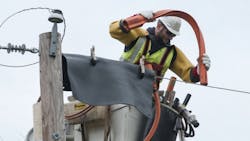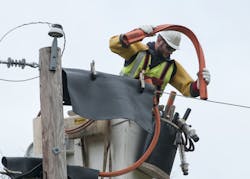PPL Electric Utilities' Linemen Respond Rapidly to Restore Power after Hurricane Sandy
Hurricane Sandy unleashed its wrath on the Northeast, knocking out power to more than 523,000 of PPL Electric Utilities' 1.4 million customers. Dubbed the worst storm in the utility's history, the hurricane affected all 29 Pennsylvania counties served by the utility, and the hardest-hit areas were in the eastern part of the service territory from Bucks and Montgomery counties up through the Lehigh Valley and into the Poconos.
To respond to this storm, the utility assembled its largest storm response workforce to date, bringing in crews from 16 other states, including its Kentucky sister utilities, Kentucky Utilities and Louisville Gas and Electric. Working together, the linemen replaced 1,813 pole crossarms, 461 poles, 601 transformers and 16,853 insulators, plus more than 100 miles of aerial lines.
Through teamwork, careful planning and access to the latest technology, the linemen were able to restore power to PPL Electric Service's customers in only eight days.
Preparing an Emergency Response Plan
Before stringing new wire, and setting and re-energizing the poles, the linemen had to wait for the storm to pass through the area. Because of the high winds, it was dangerous to have the crews working on power restoration, so the linemen initially covered the 911 and fire calls until they could safely get into the area to rebuild the lines.
The force of the hurricane winds snapped some wood poles, and in other cases, the damage was caused by trees falling on to the lines. Immediately following the hurricane, a lot of the wires were down, and the contract tree crews from Asplundh Tree Expert Co., Penn Line Service and ElectriCom worked alongside the linemen to remove the downed trees.
The utility also focused on assessing the damage caused by the hurricane to the transmission and distribution system. Helicopters flew over certain designated areas that had sustained significant damage, and in-house and contract assessors walked the lines, documented the damage and then reported back what they had found. With so many poles and wires down, it was critical to come up with a material list and then get everything spaced out properly for the crews when they arrived on site.
The utility also had to ensure that its storm center was fully staffed and up and running before the hurricane even hit the region. The storm center, which is located within the Lehigh Service Center, was staffed 24 hours a day and equipped to handle the response to the wide-scale outages and damage to the utility's infrastructure. Through meetings before the storm, PPL Electric Utilities was able to pre-stage the event before it even happened by ramping up the size of its workforce, staging material and reaching out to its counterparts.
Coordinating Crews
Before the hurricane hit, PPL Electric Utilities obtained hotel rooms, and secured food and housing for its contract crews and set up a large staging area for all of its contractors and linemen. Dorney Park, a large amusement park near Allentown, Pennsylvania, and the Wayne County Fairgrounds in northeastern Pennsylvania were temporarily transformed into self-contained camps containing trailers with bunk beds, air conditioners, heaters, laundry facilities and eating areas. Storm Services, a company that had helped other utilities after Hurricane Katrina, was brought in to set up the tent city prior to the hurricane hitting the Northeast.
By stationing the linemen at Dorney Park, PPL Electric Utilities could minimize the time necessary for the crews to travel to the job site. All the materials were staged at this location including the crossarms, cutouts, transformers and poles. Every morning, the contractors could load their trucks up with materials and leave straight from the crew camp to the restoration zone. Because they knew exactly what materials they required for each day's work, PPL Electric Utilities didn't need to transport materials back and forth to the contract crews. As such, there was a much quicker turnaround to get the material to where it needed to be.
PPL Electric Utilities crews also used laptop computers with workforce management software to increase efficiency. The computers, which were mounted in the work trucks, helped to improve the linemen's response to outages and other work requests, streamlined communication with crews in the field, and boosted customer satisfaction.
The laptops could display a map on the circuit, show GPS coordinates and receive messages from the storm center dispatchers. Linemen also could see the estimated restoration times, share this information with the contractors and customers, and guide the crews during the restoration process.
Focusing on Safety
PPL Electric Utilities called upon its own line crews as well as contractors to work a 16-hour day once restoration began, and the storm center scheduled the work for the linemen from one day to the next. The linemen's first priority was to get the three-phase backbone line up first to restore power to critical customers such as hospitals and water treatment plants.
Throughout the restoration process, the linemen had to work in extreme conditions and put in long hours, but PPL Electric Utilities' top priority was safety. As such, the utility and its contractors such as I.B. Abel Inc. and Matrix Line were able to accomplish a full restoration without any serious injuries.
One reason why PPL Electric Utilities was able to restore power safely and swiftly was the constant communication between crews. Each morning, the utility and its contractors had a safety briefing in which the managers discussed what they saw in terms of damage. These meetings helped everyone to identify what they needed to accomplish and kept everyone on the same page.
Also, the linemen were instructed not to work any lines without grounding and also use a lock out/tag out system to permit, test, and ground the lines. This work method helped to protect the linemen in case a customer was running a generator.
Another hazard that the linemen faced in the field was that of weakened trees and unsteady footing. To protect themselves, the workers wore the proper personal protective equipment such as hard hats, safety glasses, fire retardant clothing, traffic vests, Class 2 rubber gloves and sleeves, and overshoes. They also communicated with each other at all times about any hazards they encountered in the field.
The field crews also had to use their ingenuity because of limited access to certain hurricane-stricken areas. For example, one area had so many poles down, it was completely inaccessible to the linemen. Because they couldn't get a bucket truck into the area to set a pole, the linemen mounted the crossarms in the trees, and then hung the wires and insulators to quickly get the customers back in service. Then when the trees were cleared, the linemen returned to the area to make permanent repairs, replant the poles and hang the wire.
In another area, the hurricane took out an entire substation, so the linemen started rebuilding the line from the substation out and focusing on the lines feeding the substation from the transmission and distribution lines.
Planning for Future Storms
As with any storm, PPL learned lessons during the restoration process. Because Hurricane Sandy was the utility's largest storm it had ever faced, it discovered methods that worked well and areas that needed improvement.
For example, anytime the utility switches its lines or takes them out of power, it needs to carry a permit to de-energize and ground the lines. Normally this process goes through a system operator, but moving forward, the utility will appoint a lead person in the field to act as a system operator at a substation. This manager will take control of the substation switching and permits, which will alleviate the high volume of calls into the system operator. It will also grant control to one individual who can take a circuit or substation and handle the restoration.
For the next major storm, PPL Electric Utilities plans to once again set up a crew camp due to the time savings and increased productivity of the field crews. The storm center also played a vital role in the restoration effort, allowing the company to coordinate the work crews efficiently and to restore power to its customers rapidly.
Another successful strategy was asking field crews to provide field assessments and estimated restoration times. The utility then shared this information with its customers, who came to expect these constant updates. Both now and in the future, PPL Electric Utilities will offer outage updates via text messages, e-mails or phone calls, along with information posted to its website.
Throughout the restoration effort, PPL Electric Utilities crews used their creativity and determination to restore power. The linemen had to work long hours because of the magnitude of the storm, and they completed the job safely. They had a lot of pride in their job, and they wanted to get the customers back in power quickly and safely.
After the hurricane, however, PPL Electric Utilities crews didn't take a long deserved break. Instead, some left their service territory and traveled to New Jersey to help PSE&G with restoration. Just as other contractors and utilities came to PPL Electric Utilities' aid, the utility helped the New Jersey utility to restore power to its customers, rebuild after Hurricane Sandy's destruction and get the Northeast back up and running.
Wayne Grim ([email protected]) is a field manager for PPL Electric Utilities' distribution operations department. He has been with the company for 28 years and manages linemen and foremen at three service centers. Grim played a critical role in the company's cleanup efforts in the Lehigh Valley area of eastern Pennsylvania, one of the areas hardest hit by Hurricane Sandy.
Asplundh Tree Expert Co. | www.asplundh.com
ElectriCom | www.electricominc.com
I.B. Abel Inc. | www.ib-abel.com
Kentucky Utilities and Louisville Gas and Electric
www.lge-ku.com
Storm Services LLC | www.stormsl.com
Penn Line Service | www.pennlineservice.com
PPL Electric Utilities | www.pplelectric.com

